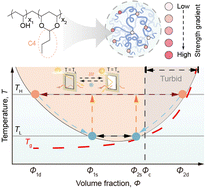Engineering a polyvinyl butyral hydrogel as a thermochromic interlayer for energy-saving windows†
Abstract
Achieving mastery over light using thermochromic materials is crucial for energy-saving glazing. However, challenges such as high production costs, limited durability, and recyclability issues have hindered their widespread application in buildings. Herein, we develop a glass interlayer made of a polyvinyl butyral-based hydrogel swollen with LiCl solution. In addition to a fast, isochoric, and reversible transparency-to-opacity transition occurring as ambient temperatures exceed thermally comfortable levels, this hydrogel uniquely encompasses multiple features such as frost resistance, recyclability, scalability, and toughness. The combination of these features is achieved through a delicate balance of polyvinyl butyral's amphiphilicity and the suppression of network-forming phase separation. This design endows a nanostructured polyvinyl butyral–LiCl composite gel with swollen molecular segments linked by dispersed cross-linking sites in the form of hydrophobic nano-nodules. Upon laminating this hydrogel (a thickness of 0.3 mm), the resultant glazing product demonstrates approximately 90% luminous transmittance even at sub-zero temperatures, along with a significant modulation of solar and infrared radiation at 80.8% and 68.5%, respectively. Through simulations, we determined that windows equipped with the hydrogel could reduce energy consumption by 36% compared to conventional glass windows in warm seasons. The widespread adoption of polyvinyl butyral in construction underscores the promise of this hydrogel as a thermochromic interlayer for glazing.



 Please wait while we load your content...
Please wait while we load your content...